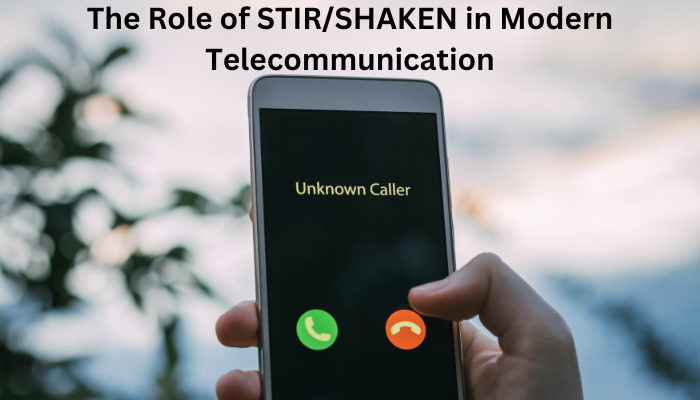
The Role of STIR/SHAKEN in Modern Telecommunication
September 4, 2024 Comment off
In an era where digital communication is indispensable, telecommunication networks face mounting threats, particularly from fraudulent calls. Robocalls and caller ID spoofing, where attackers disguise their real numbers as legitimate ones, have surged dramatically. Consumers often find themselves questioning the authenticity of incoming calls, leading to distrust, missed legitimate calls, and heightened frustration. In response to this, the telecommunications industry, alongside regulators, has implemented the STIR/SHAKEN protocols, which have become a cornerstone in fighting caller ID spoofing and restoring trust in voice communication.
What Is STIR/SHAKEN?
STIR (Secure Telephone Identity Revisited) and SHAKEN (Signature-based Handling of Asserted Information Using toKENs) are frameworks designed to ensure the authenticity of a caller’s identity in telephone networks. These protocols provide a way to validate that the caller ID information displayed during a phone call matches the true identity of the originating caller.
STIR is a set of standards that allow telephone service providers to authenticate the identity of a caller using digital certificates. SHAKEN, on the other hand, is the implementation of these standards specifically in Internet Protocol (IP)-based networks, which are becoming the backbone of modern telecommunication.
Together, these protocols create a secure framework for verifying that a call is truly coming from the number displayed on the caller ID. The goal of STIR/SHAKEN is to prevent bad actors from spoofing numbers and improve the reliability of telecommunication systems.
How Do STIR/SHAKEN Protocols Work?
The STIR/SHAKEN protocols function through a series of steps that verify the authenticity of a caller’s identity:
- Call Origination: When a call is initiated, the originating service provider generates a SIP (Session Initiation Protocol) invite that contains the caller’s phone number.
- Attestation Level: The provider then assigns an attestation level that reflects how confident they are in the caller’s identity. There are three levels:
- Full Attestation (A): The provider has verified the identity of the customer and their right to use the calling number.
- Partial Attestation (B): The provider knows the customer but cannot verify the legitimacy of the calling number.
- Gateway Attestation (C): The provider cannot verify the identity of the customer because the call originated from outside their network (often from international or third-party sources).
- Signing the Call: The service provider then signs the call with a digital certificate issued by an authorized Certificate Authority (CA). This signature is a cryptographic proof of the caller’s identity.
- Call Routing and Verification: The call is routed to the receiving provider, who checks the digital signature using the originating provider’s certificate. If the signature is valid, the receiving provider can assure the recipient that the caller ID is authentic.
Implementation Timeline and Key Milestones
The implementation of STIR/SHAKEN in the United States has been driven primarily by regulatory mandates. In 2019, the Federal Communications Commission (FCC) required major telecommunications providers to implement the framework by June 30, 2021. This requirement applied to large voice service providers operating in IP-based networks, marking a significant step toward widespread adoption.
However, to ensure that smaller providers also comply with the standards, the FCC extended the timeline for certain smaller and rural carriers to June 30, 2023. As of 2024, most providers have implemented STIR/SHAKEN or are in the process of doing so, even in hybrid networks where some legacy systems are still in use.
Why STIR/SHAKEN Matters in Modern Telecommunication
- Combatting Fraudulent Calls: One of the most significant advantages of STIR/SHAKEN is its ability to reduce caller ID spoofing. Bad actors often use spoofed numbers to conduct scams, such as phishing attempts or robocalls, tricking consumers into divulging sensitive information. By authenticating calls, these protocols make it much harder for scammers to impersonate legitimate entities.
- Building Consumer Trust: With millions of fraudulent calls made daily, trust in phone calls has eroded significantly. STIR/SHAKEN helps restore that trust by ensuring that consumers can be more confident that the number they see is accurate, leading to fewer unanswered calls and more legitimate communications.
- Regulatory Compliance: Governments and regulators, particularly in the U.S. and Canada, have mandated STIR/SHAKEN implementation as part of broader efforts to protect consumers from fraud. Non-compliance with these mandates can result in penalties, so adherence to these protocols is becoming a critical business requirement for telecom operators.
- Enhanced Call Analytics: In addition to verifying caller identity, STIR/SHAKEN improves call analytics capabilities. Telecom providers can more effectively trace and block suspicious call patterns, further reducing the volume of robocalls that reach consumers.
- Future-Proofing Telecommunications: As telecommunication evolves, with more services migrating to IP-based networks and the rise of Voice over IP (VoIP) systems, STIR/SHAKEN protocols ensure that verification processes remain robust. This is crucial as the industry transitions to more modern, internet-driven communication systems.
Challenges and Future Outlook
While STIR/SHAKEN is a powerful tool for reducing caller ID spoofing, it is not without challenges. One of the most notable limitations is that it only works on IP-based networks, meaning traditional landlines and older telecommunication systems may not fully benefit from these protections. Additionally, international calls originating from countries that have not implemented similar frameworks are harder to verify.
However, as more countries adopt STIR/SHAKEN or similar frameworks, and as telecommunications continue to migrate to IP-based systems globally, these protocols will play an even more prominent role in securing voice communications.
Looking ahead, telecom companies will likely expand STIR/SHAKEN’s capabilities, integrating it with emerging technologies like artificial intelligence to further enhance fraud detection. The combination of verification frameworks and advanced analytics may provide an even stronger shield against future threats.
STIR/SHAKEN represents a critical advancement in securing telecommunication networks from the growing threat of caller ID spoofing and fraud. By creating a system where calls are authenticated before they reach consumers, these protocols offer a much-needed layer of trust in today’s communication ecosystem. As adoption spreads globally and technology evolves, STIR/SHAKEN is poised to play a key role in shaping the future of secure, reliable voice communications.